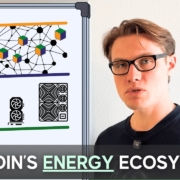The Electric Economy: Bitcoin, AI, Robotics, Drones and You! | Hashpower Academy
Bitcoin isn’t just money—it’s energy money!
I dive into its economic energy ecosystem, where BTC is mathematically tied to electricity (BTC/kWh), not dollars.
Miners consume ~20 GW globally (913.5 EH/s) to secure the network, producing 454.2 BTC daily at ~0.00096 BTC/MWh. Production costs? 43-70% of revenue ($114/MWh) at $50-$80/MWh energy rates. In an electrified world of AI, robotics, and drones, Bitcoin’s hashrate stabilizes the grid, balancing the chaos & order of financial and energy markets.
Future? Local solar-battery-mining setups price electricity in sats, creating circular economies.
Watch now—discover how Bitcoin powers a system of energy/money interchangeability.
– – – – – – – – – – – – – – – – – – – – – – – – – – – – – – –
Hashpower Academy Donations (Thank You!):
L1 Bitcoin: bc1qlgkc4pyrz22cykrx49cmuku3zyy2nuequu6r9y
L2 Lightning: academy@walletofsatoshi.com
Hosted Bitcoin Mining accessible to Everyone: (Waitlist)
https://www.Terahash.Finance/Platform
The Big Picture Basics (Free Bitcoin Course)
https://www.hashpower.academy
Request a Video Topic – Hashpower Academy
https://forms.gle/em32yYXt7TtC3qUY6
Align a meeting if you are looking to explore Mining/Hosting and other Business/Consultation Inquiries:
https://calendly.com/terahash/30min
– – – – – – – – – – – – – – – – – – – – – – – – – – – – – – –
*Affiliate Links to support the Hashpower Academy,*
By exploring Products, Markets & Services across the Bitcoin Ecosystem:
*Wallets – for Self Custody*
Trezor: https://affil.trezor.io/SHpa
Ledger: https://shop.ledger.com/?r=0e5e239ec8ba
Blockstream: https://store.blockstream.com/?code=academy
Ngrave: https://www.ngrave.io/?sca_ref=9211144.4mNYVms7D0
*Miners – for the Home*
HeatBit: https://heatbit.com/?ref=academy
SoloSatoshi: https://www.solosatoshi.com/aff/1405/
IxTech: https://ixtech.xyz/?ref=JAKE
Cloaks: https://www.cryptocloaks.com/aff/Academy/
*Platforms to Explore*
ViaBTC Pool: https://www.viabtc.info/signup?refer=1553491
TradingView: https://www.tradingview.com/?aff_id=154436
BitRefill: https://www.bitrefill.com/invite/68zjuypv
– – – – – – – – – – – – – – – – – – – – – – – – – – – – – – –
Financial Disclaimer:
This video serves educational and informational purposes only and should not be construed as financial advice or investment recommendation. The views expressed are those of the presenter and do not represent Hashpower Academy’s official stance. Information is provided ‘as is’ without warranties, express or implied, as to its accuracy or completeness. Engaging with Bitcoin involves high risk, including potential financial loss, market volatility, and energy costs, and is suitable only for those who can bear these risks. Always conduct your own research and consult with a qualified financial or technical advisor before making decisions related to Bitcoin.
#Bitcoin #BTC #EconomicEnergy #BitcoinMining #Crypto #EnergyMoney #Hashrate #circulareconomy Economy #CryptoFinance #GridStability #BitcoinEducation #ElectricityPricing #Blockchain #SolarPunk #MiningEfficiency #satoshi #bitcoineconomy #EnergyEcosystem #Investing #BitcoinNetwork
Video Transcript:
Hello there and welcome to the Hash Power Academy, your place to learn anything to do with Bitcoin. The topic of today’s video is about Bitcoin’s economic energy ecosystem, which essentially means that Bitcoin is an energybased form of money, and it’s not through dollars. It’s through its mathematical connection to electricity directly in of itself. Now, is electricity important in today’s day and age? Well, let’s run off the list. AI, robotics, drones, mining, and we’ll throw you in there as well because just about everything to do with the modern life now depends on electricity, and we need a lot of it. So, we need an economic system which rotates capital, energy, and money in a circular way so all of this stuff can get built out whilst also making sure that the electrical grid, as the key example, remains stable. Because yes, we can build more solar and wind, but the problem is you only get power when nature will give it to you, not when you want to switch on the lights or charge your phone. And that discrepancy requires something to manage and maintain those fluctuations between the chaos and order of the energy system and the financial sector. And that’s what Bitcoin mining does in the middle of the blockchain and the electrical grid. So, let’s just go through these numbers. It’s just two multiplication steps to help you understand that it’s mathematically connected to electricity without a dollar in there. The dollar comes afterwards when you start pricing the input cost of energy and the output value of the Bitcoin mind, the Bitcoin price. We’ll also throw in there some production cost estimates from the from these three figures of energy billing on the other side. But these three amounts of uh dollar per megawatt hour is just associated to a quantity of electricity. What this shows you is Bitcoin is mathematically connected to a quantity of electricity. Quantity of Bitcoin to a quantity of electricity. Again, no dollars. So, let’s dive in. The difficulty figure of 127.62 62 trillion is a metric trying to gauge how quickly blocks are being mined by the network and constraining that to about 144 per day. If more energy is being consumed through more computers being deployed producing more hash rate in the proof of more blocks being added in a quicker shorter period of time the difficulty increases. If less energy, less computes online, difficulty will come down when looking back over a extended two week and beyond period. But let’s go through the numbers. So 127.62 multiplied by, we’ll keep it short, 7.15 approximates out to about 913.5 xahash or 93 million terraash. Now, that is a lot of compute power. That’s making the Bitcoin network more secure than if you coordinated all of the super supercomputers of the world to try and interrupt this very secure financial ledger. So, 913.5x aash. Now when you multiply that by the average efficiency of Bitcoin mining hardware which efficiency is measured at the exchange rate of energy consumed versus output performance of the computer. When you go into the shop and ask for a fast computer, you’re trying you’re trying to understand how much energy it consumes versus the output performance of the computer. Now this is watts per terraash and as you can see this is xahash. So what you can do is you multiply up both sides by a factor of a million. So you get megaww per xahash. So it’s the same thing as watts per terahash. 93.5 times by 21.55 is done the numbers 19 685 megaww otherwise known as approximately 20 gawatt of power which is a lot of power that’s larger than some countries energy use. So that’s how that’s the amount of power being roughly used right now in real time across the planet by the Bitcoin network. So yeah, Bitcoin has no infrastructure except for a planetary amount of infrastructure being built continually all around the world. And when you apply the amount of Bitcoin being earned per day, which is 454 roughly right now, 54.2 two bitcoin. So that’s about per day. Now if we want to understand things in megawatt hours, we’ll divide that down by 24, which is 18.925 hour. So 18.925 bitcoin is being earned by the entire Bitcoin network in roughly six blocks per hour. Now, if you divide that amount of Bitcoin by 19,685, I’m going have to write this out. 0 0 96139. So, that’s the amount of Bitcoin being earned per megawatt hour by the entire network as an average. Remember there’s different miners with different efficiencies, different up times, different power costs. So just understanding the connectivity of the entire chain is the first step. Then you can delve into fiddling with different particular numbers or rearranging figures to understanding how much Bitcoin you earning per terahash or per computer or in this case we’re looking at it per megawatt. And you could divide this figure down by a factor of a th00and divided by th00and and you get the figure per kilowatt hour. Now multiply this 0 0 96139 by 50 65 or 80. Uh sorry no wrong way round. Ignore that. You your this is what you’re earning is revenue and you’re applying it against these three figures. This multiplied by the current price of 119,000 is you’re earning about what is it $114. The revenue per megawatt hour of the average of the network is $114 per megawatt hour. Divide that by thousand and it’s about 11.4 cent per kilowatt hour. Now, if you’re paying $50, $65, or $80 as the typical range from uh volume of mining machines, uh a very generous hosted miner and the upper retail price per per megawatt hour, but it’s typically in kilowatt. So, it would be 8 cent 5 to 8 cent. You’re paying 5 to 8 cent against earning 11 cent as a network average. Now, if you’ve got more efficient machines, you earn more against this energy cost. That’s why efficiency is so important in this network. But the key aspect here is you’ve got a quantity of Bitcoin mathematically connected to a quantity of energy and then people start dollarizing everything. And so the interesting takeaways here are if you divide the 50 by 104 114 you get a production cost of about 43%. 43%. Uh 65 divided by 114 is about 57%. And uh 80 divid 114 is about 70%. So those are production floor percentages. So 119 multiplied by this, this and this and you get a a gauge of the sort of production cost of of different prices of of energy cost. The other aspect that changes this is the key metric of efficiency and the global one that no individual really has control of is the amount of block rewards. So this is the global pricing at this level and this is your local pricing based on your efficiency of computer and the price that you pay for energy. But yeah, as a network average it’s about this amount of Bitcoin per megawatt hour and then you start dollarizing it. Um I am going to release a document a Google sheet that automates all of these figures and we’ll use the live price of Bitcoin. I have pulled um the blockchain data into the sheet as well so you can see the sort of amount of profitability per terahash per machine per megawatt hour all these different components because I think it’s really interesting to learn Bitcoin from this perspective because the future of Bitcoin is that now electricity can be defined in a quantity of sats well as more local circular economies are built which is solar battery mining and your little setup is connected to all of your local community of houses. When you’re not at home, you go on holiday, your energy can be flowing to other people if they need to buy it. And the price that you would set this one and the more you switch off, it improves the efficiency of the computer, which reprices this even higher. So there’s this natural elasticity to Bitcoin’s economic pricing to electricity. It’s really interesting. But here’s the thing. In this new electric economy of AI, drones, robotics, vehicles, everything consuming electricity, having a system that just directly prices electricity and a quantity of money creates a switching system with the hash rate in the middle to manage the chaos and order with hash rate as that yin-yang boundary layer between these two worlds. This is the sort of stuff that I am absolutely obsessed with focused on building out and I have a platform which starts the the economics journey of this of getting as many computers and then as those computers get of an older age and have produced a lot of Bitcoin. Those computers then can now be deployed out into the world to create this pricing system of electricity on a Bitcoin unit account. And some more financial layers that will lock the energy rates in fixed prices creates fixed price contracts that merchants can pay their energy bills in Bitcoin, receive Bitcoin, and those natural other circular economies extend off of this economic energy ecosystem. Thank you for listening. I ran out of breath. Hope you enjoyed. Like, subscribe, share, and all that fun stuff. And I will see you in the next video. Goodbye.














Leave a Reply
Want to join the discussion?Feel free to contribute!